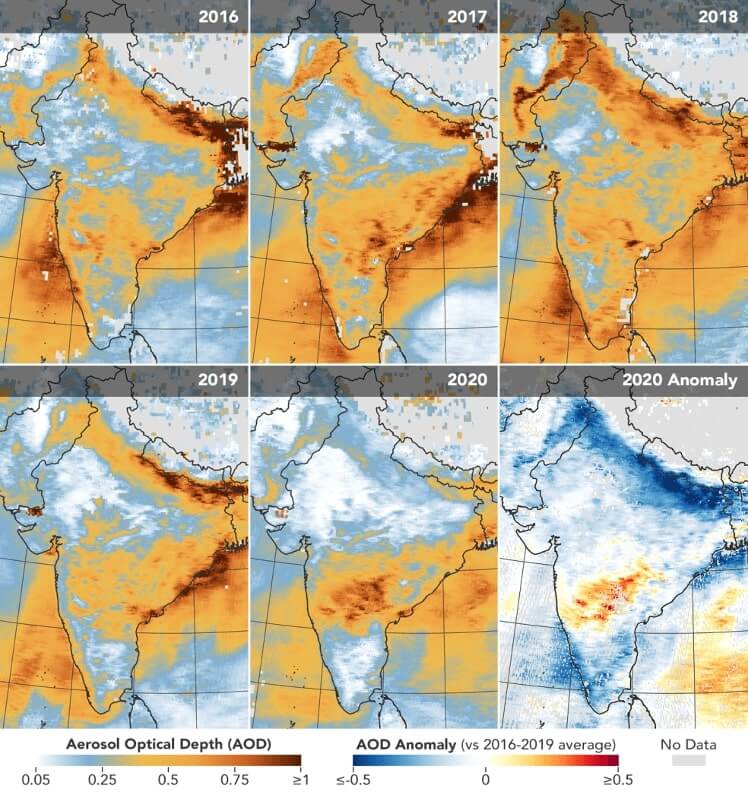
In the current situation, the world is crumbling from COVID-19 but at the same time it has helped in solving the climatic riddles. Due to the lockdown, Indians are breathing pure oxygen which had not happened since 20 years. As people are not going out, the number of vehicles in the road has become less so the pollution has been decreased, sky has become so clear, rivers look clean, wind speed and direction has become normal, etc,. The only positive news of this lockdown is “Earth Is Healing”.
The first five maps on right show aerosol optical depth (AOD) measurements over India during the period of March 31 to April 05 for each year from 2016 through 2020. The sixth map (anomaly) shows how AOD in 2020 compared to the average for 2016-19.
Aerosol and its Types
Aerosol is a suspension of small particles either in the form of solid or liquid in gas, air, smoke, and fog. Its radius is about 0.1 to 10microns. Aerosol is an abbreviation of “aero-solutions”. There is a marked difference in the levels of aerosol which are at its lowest in 20 years.
AOD is a measure of how light is absorbed or reflected by airborne particles as it travels through atmosphere.
This lockdown has done many unintended things in our nation. In the first few days of the lockdown, it was difficult to observe a change in the pollution signature. “We saw an aerosol decrease in the first week of the shutdown, but that was due to a combination of rain and the lockdown,” said Gupta. As a result of rainfall, the air was clear of aerosols over areas across north India. After the rainfall, it was shocked to see aerosol levels did not go up and return to normal. However, according to the satellite data, aerosol levels did not yet decrease to the same extent in south India.
There are many different sources. Major sources are- Natural and Man-made sources.
Natural sources:
- Sea salt
- Volcanic dust
- Mineral dust
- Oceanic sulphates
- Cloud condensation nuclei
Man-made sources:
- Black Carbon
- Industrial sulfates
- Organic particles
We all knew that climatic conditions would change due to this lockdown, but decrease in the Indo-Gangetic Plain at this time of year is really so delightful. In addition to their role in climate, aerosols are also of interest because they decrease visibility, contribute to acid rain, and can affect human health. Numerous international studies have looked at the relationship between aerosols and increased mortality. According to a recent international Commonwealth Science Council conference, air pollution kills eight thousand people every day worldwide. Aerosols can be a health hazard and can damage the lungs and heart.
Pollution in Northern India


How aerosol impacts to our body
Aerosol properties and processes affect the climatic as well as human health. Atmospheric properties play a major role related to the quality of air which affects human health. The health impacts of aerosols consist of both short-term acute symptoms, like asthma and bronchitis, and long-term chronic irritation and inflammation of the respiratory track, which can potentially lead to cancer. Moreover, during this relatively short time period there was a significant increase in hospitalizations for upper respiratory tract infections (15%) and bronchitis (49%). Additionally, epidemiological studies have found a correlation between daily mortality, daily hospitalization data and particle concentrations in outdoor air. These studies are central to the decision of the EPA to propose new tighter particle standards. Of particular interest is asthma. Asthma is a chronic inflammatory disorder of the lungs characterized by episodic and reversible symptoms of airflow obstruction (NIH). Of particular interest is asthma.
It even causes Chronic obstructive pulmonary disease (COPD) which is a common lung disease. Some cases of COPD are due to long-term asthma. COPD makes a person hard to breathe. COPD not only occurs to the person who smokes more often but it also occurs due to certain gases or fumes in the workplace, heavy amounts of secondhand smoke and pollution, and it also occurs due to frequent use of a cooking fire without proper ventilation.
It was said that COPD is likely to increase in coming years due to higher smoking prevalence and aging populations in many countries. But the current situation has made a very big impact on healthcare sector in long run. However, because of the less pollution, COPD patients will eventually reduce visiting hospitals. As it is more likely to be caused by outdoor air pollution and occupational dusts and chemicals (such as vapours, irritants, and fumes), the rate of COPD patients were being increased day by day. But now the situation is different due to COVID-19. The pollution has become less which had not happened since 20 years and moreover, people have been instructed to stay at home. As the people are staying at home, they are less affected by the air pollution and the number of COPD patients is getting decreased eventually. So, frequent visit to the hospitals by COPD patients is also decreasing.
Conclusion
We, Indians are happy to see the current climatic conditions in northern India due to the lockdown. As the aerosol condition of northern India has come to normal, we should try to keep the environment safer even after the lockdown opens. People should try to avoid the pollutions which are caused by industrial factories, vehicles, burning of plastics, etc,.


